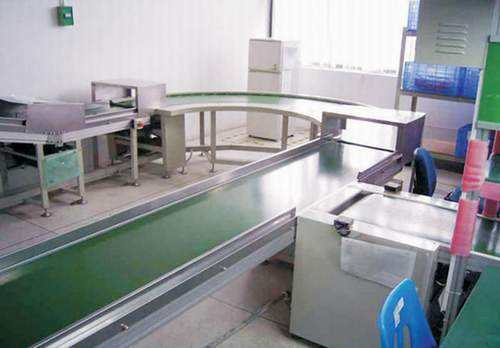The belt assembly line is a kind of assembly line and occupies a large market. Therefore, all large enterprises have been transformed to use the assembly line to save labor and improve work efficiency. It can transport a wide variety of materials, can transport all kinds of bulk materials, can also transport a variety of cartons, bags and other single lighter weight products, can also be used for large supermarkets at the cash register of goods delivery, a wide range of uses. Belt conveyor has the advantages of large conveying capacity, simple structure, convenient maintenance and standardization of parts. It is widely used in mining, metallurgy, coal and other industries to transport loose materials or articles, and can be transported by single station according to the requirements of the transportation process. , It can also be composed of multiple horizontal or inclined conveying systems composed of other conveying equipments to meet the requirements of different layouts. It is suitable for transporting bulk density less than 1.67/ton/m3 and easy to pick up powder and granular , Small pieces of low-grinding materials and bags of materials, such as coal, gravel, sand, cement, fertilizer, food and so on. The temperature of the material to be sent is less than 60°C. The captain and the assembly form can be determined according to the user's requirements. The electric roller can be used for the transmission, and the drive device with a drive frame can also be used. Classification of belt lines Belt conveyors have a variety of structural forms, including grooved belt conveyors, flat belt conveyors, climbing belt conveyors, roll belt conveyors, and belt conveyors. Commonly-used belt conveyors can be divided into: ordinary canvas core belt conveyors, steel cord high-strength belt conveyors, all-explosion conveyor belt conveyors, flame-retardant belt conveyors, double-speed double conveyor belt conveyors, and reversible movements. Belt Conveyor, Cold Belt Conveyor, etc. The belt conveyor is mainly composed of a frame, a conveyor belt, a belt roller, a tensioning device, a transmission device and the like. The use of belt lines Belt line can transport a wide range of materials, can transport all kinds of bulk materials, but also transport all kinds of cardboard boxes, bags and other single pieces of light weight of goods, a wide range of uses. Conveyor with rubber, canvas, PVC, PU and other materials, in addition to the transport of ordinary materials, but also to meet the oil, corrosion resistance, anti-static and other special requirements of the material delivery. The use of dedicated food grade conveyor belts can meet the requirements of food, pharmaceutical, and daily-use chemical industries. Smooth conveying, there is no relative movement between the material and the conveyor belt, which can avoid damage to the conveyed material. Compared with other conveyors, it has less noise and is suitable for quiet working environments. Simple structure, easy maintenance; less energy consumption, low cost of use. Belt line operation Before running the belt assembly line, first make sure that the belt line equipment, personnel, and items to be transported are all in a safe and sound condition; second, check that all moving parts are normally free of foreign matter, check whether all electrical lines are normal, and put the belt line into operation when it is normal. Finally, check that the difference between the supply voltage and the rated voltage of the equipment does not exceed ±5%. To operate in the belt line operation, the following operations must be performed: 1. Close the main power switch and check that the device power is properly fed in and the power indicator is on. After the normal operation, proceed to the next step. 2. Close the power switch of each circuit and check if it is normal. Under normal conditions, the equipment does not move, the belt line running indicator does not light, the power indicator of the inverter and other equipment is on, and the inverter's display panel displays normal (no fault code display). 3. Start each electrical equipment in sequence according to the technological process. After the previous electrical equipment starts normally (motor or other equipment has reached normal speed and normal state), start the next electrical equipment. In the operation of the belt line, the provisions of the articles in the design of the conveyed goods must be observed and the design capabilities of the belt line must be observed. Second, it should be noted that all types of personnel must not touch the moving parts of the belt line, non-professionals must not be free to contact electrical components, control buttons, etc. Finally, in the operation of the belt line, it is not possible to open the circuit to the rear stage of the inverter. If it is necessary to confirm the maintenance, it must be performed when the inverter is stopped. Otherwise, the inverter may be damaged. When the belt line is stopped, press the stop button to stop the system and stop the main power supply. Customized Equipment Enclosures,Waterproof Enclosures,Powder Coated Enclosures,Non-Standard Enclosures FCX Metal Structure Co., Ltd. , https://www.fcxmetal.com
Classification and use of belt lines
Belt line introduction Â